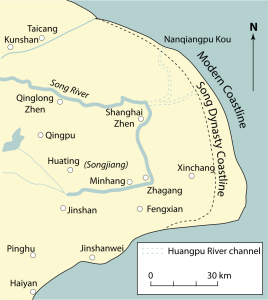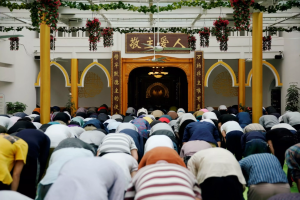Shanghai
24 History/Religion
Zahra Gokal
Shanghai’s History
Early History

Shanghai was not originally known as Shanghai; a simple fishing and agricultural village, it was known as Hudu back in its early era. In its early days, Shanghai was not a significant area in terms of population growth or economic status. Its coastal location ensured its status as a great port within the coming years. The population gradually increased and the village officially rose to a higher status during the Song dynasty (960-1126), turning into a market town. During the Yuan dynasty in 1291, it became an official city.
Ming Dynasty
During the Ming Dynasty, Shanghai’s reputation as a port grew. A wall was erected around the city in order to ward off Japanese pirates and to make sure the shipping industry was not affected at all. The city had a cotton and textile industry to maintain as well, growing rapidly by the time the next dynasty came around. The population was almost 200,000 by the time the 17th century came along.
Opium Wars
The East India Company explored Shanghai in hopes of finding spices or opium to trade. Opium was illegal in China, but Britain offered it to be a profitable trading good and initiated a war. The Opium Wars took place from 1839 to 1860. Britain won the first Opium War with the Treaty of Nanjing, allowing Shanghai’s port to be open to all foreigners including the French, Americans, and British. They were allowed a certain portion of the city to occupy while the rest of the natives stayed in another location.
Republic of China and WWII
A revolution took place in 1911 which established China as a republic, thus putting an end to the dynasties. Immediately following this, Shanghai experienced many more major events. The Chinese Communist Party formed in Shanghai in 1921 due to power struggles in the new republic. This time period was also the center of an opium struggle. The city took in many refugees from the Holocaust in the 1930s during World War II. Shanghai was divided into a Western and Eastern half: its Western half, which housed European settlers, grew four times as much as the Eastern half, which housed Chinese citizens.
World War II was tough on Shanghai, as it became a battlefield quite a few times. On January 28, 1932, the city was bombed by the Imperial Japanese Navy Air Service, to which China retaliated. The battle eventually came to a standstill. This event was known as the January 28 Incident or the Shanghai Incident.
In 1937, the Battle of Shanghai took place, the first of many battles which signified the Second Sino-Japanese War. Many Chinese parts of the city fell during this time, and assassinations happened left and right. The Japanese continued to occupy Shanghai until their surrender in August 1945.
In 1949, the Communist Party took over Shanghai. People who were considered counter-revolutionaries were targeted and killed.
Shanghai Today
Today, Shanghai stands as a center of economic life, building up the city’s famous skyline. It is the largest city in China by population, reaching almost 25 million people.
Despite this, it is also at risk of flooding due to climate change. The main problems today are air and water pollution in Shanghai. Poor water quality means that it can get into one’s system, while poor air quality means a tougher time breathing. More environmental efforts are underway in order to improve life quality in Shanghai.
Shanghai’s Religions
Shanghai has a diverse population and a rich history, having been influenced by a variety of religions around the area. The city recognizes five religions (Buddhism, Catholicism, Daoism, Islam, and Protestantism), but the Chinese Communist Party is atheist. One of the biggest religions in Shanghai is the Chinese folk religion, which consists of ancestors, spirits, and deities.

According to Council on Foreign Affairs, as of 2020, Shanghai is:
- 31.8% Agnostic
- 30.8% Chinese folk-religionist
- 16.6% Buddhist
- 7.4% Christian
- 6.8% Atheist
- 1.8% Muslim
- 0.4% Daoist
- 0.2% Other
Works Cited
Albert, Eleanor, and Lindsay Maizland. “The State of Religion in China.” Council on Foreign Relations, 25 Sept. 2020, www.cfr.org/backgrounder/religion-china.
“Discover the Rich History of Shanghai.” World Travel Guide, www.worldtravelguide.net/guides/asia/china/shanghai/history/.
“History of Shanghai.” Www.youtube.com, www.youtube.com/watch?v=qUIuoe2stdM.
“Shanghai City Map | Tourist Map of Shanghai Attractions | Map of Shanghai China.” Tripstoshanghai.com, tripstoshanghai.com/shanghai/shanghai_maps.htm. Accessed 15 Nov. 2022.
“Shanghai Is Most Sustainable City in Mainland China | Industry Insights.” APAC Outlook Magazine, www.apacoutlookmag.com/industry-insights/article/405-shanghai-is-most-sustainable-city-in-mainland-china.
The Editors of Encyclopaedia Britannica. “Chinese Revolution | 1911-1912 | Britannica.” Encyclopædia Britannica, 2019, www.britannica.com/event/Chinese-Revolution-1911-1912.
Yan Zhongmin. “Shanghai: the Growth and Shifting Emphasis of China’s Largest City.” Chinese Cities, the Growth of the Metropolis Since 1949, 1984.
Yeung, Yue-Man, and Victor F. S. Sit. “Chinese Cities: The Growth of the Metropolis since 1949.” Geographical Review, vol. 76, no. 2, Apr. 1986, p. 211, 10.2307/214627. Accessed 22 Nov. 2022.
Media Attributions
- shanghai
- rts2i2sk

